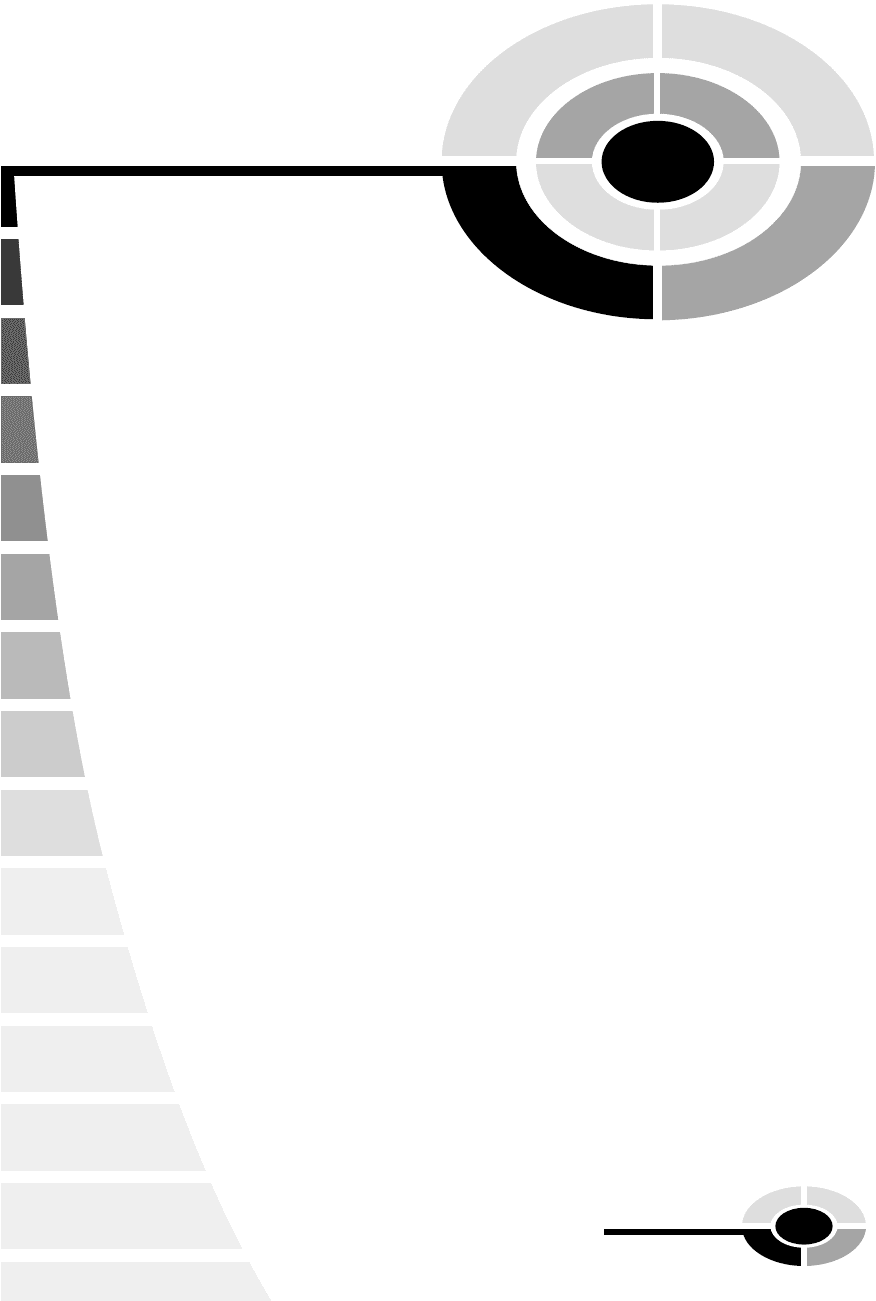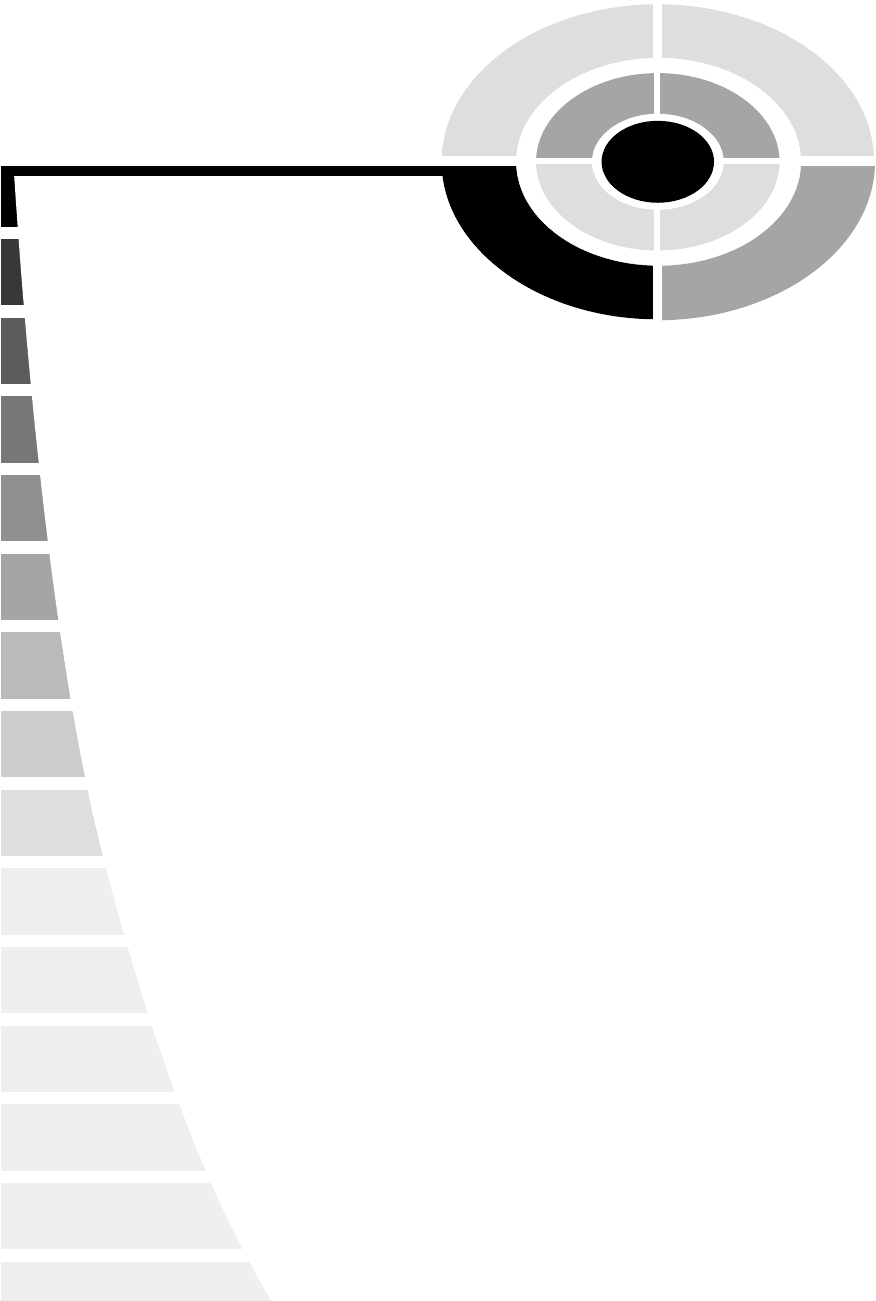Layman D. Biology Demystified: A Self-Teaching Guide
Подождите немного. Документ загружается.


5. Members of the Class Chondrichthyes basically differ from those of the
Class Osteichthyes in that:
(a) Osteichthyes includes salamanders
(b) Chondrichthyes involves the bony fishes
(c) Osteichthyes consists of fish, only
(d) Chondrichthyes is composed of fish with skeletons of cartilage
6. An amnion:
(a) Takes its name from its remarkable resemblance to a ‘‘little
peanut’’
(b) Chiefly consists of a fluid-filled sac encasing the embryos of higher
vertebrates
(c) Principally entails a naked embryo surrounded by a hard shell
(d) Represents a stage of reptiles with gills
7. Archaeopteryx is important for biological study because:
(a) This ancient vetebrate may have been a bridge between reptiles and
modern birds
(b) It probably did not appear until after all the dinosaurs had gone
(c) There are many marsupials that resemble this creature
(d) It likely gave birth to live young
8. To say that modern birds are homeothermic is basically to claim that
they:
(a) Cannot easily control their own internal body temperature
(b) Do not have the capability to adapt to extremely cold
environments
(c) Can keep their body temperatures in a relatively stable range
(d) Have lost their appetite for insects
9. The Class Mammalia get their name from what obvious characteristic?
(a) Hairy bodies
(b) Breasts containing milk-secreting glands
(c) Thick craniums holding large brains
(d) Viviparous birthing without eggs
10. The three major groups of mammals:
(a) Aves, Reptilia, Amphibia
(b) Koalas, opossums, and platypuses
(c) Monotremes, marsupials, and placentals
CHAPTER 12 The Chordata 207
[13:25 13/6/03 N:/4058 LAYMAN.751/4058-Alltext.3d] Ref: 4058 Layman: Biology Demystified All-text Page: 207 1-388

The Giraffe ORDER TABLE for Chapter 12
(Key Text Facts About Biological Order Within An Organism)
1. ____________________________________________________________
2. ____________________________________________________________
3. ____________________________________________________________
4. ____________________________________________________________
The Spider Web ORDER TABLE for Chapter 12
(Key Text Facts About Biological Order Beyond The Individual
Organism)
1. ____________________________________________________________
2. ____________________________________________________________
3. ____________________________________________________________
4. ____________________________________________________________
5. ____________________________________________________________
The Broken Spider Web DISORDER TABLE for Chapter 12
(Key Text Facts About Biological Disorder Beyond The Individual
Organism)
1. ____________________________________________________________
[13:25 13/6/03 N:/4058 LAYMAN.751/4058-Alltext.3d] Ref: 4058 Layman: Biology Demystified All-text Page: 208 1-388
PART 3 Five Kingdoms of Life, plus Viruses
208

[13:25 13/6/03 N:/4058 LAYMAN.751/4058-Alltext.3d] Ref: 4058 Layman: Biology Demystified All-text Page: 209 1-388
209
Test: Part three
DO NOT REFER TO THE TEXT WHEN TAKING THIS TEST. A good
score is at least 18 (out of 25 questions) correct. Answers are in the back of
the book. It’s best to have a friend check your score the first time, so you
won’t memorize the answers if you want to take the test again.
1. Biological discipline which defines and classifies different groups of
organisms:
(a) Ecology
(b) Anatomy
(c) Taxonomy
(d) Physiology
(e) Bacteriology
2. The bacteria and all other types of prokaryotes are members of this
kingdom:
(a) Bacteriae
(b) Monera
(c) Plantae
(d) Animalia
(e) Fungi
Copyright 2003 by The McGraw-Hill Companies, Inc. Click Here for Terms of Use.

3. A group of bacteria that use nitrogen-fixation to produce their food:
(a) Photoautotrophs
(b) Heterotrophs
(c) Chemoautotrophs
(d) Gram-positive
(e) Gram-negative
4. Comes from the Latin for ‘‘poison’’:
(a) Bacteremia
(b) Septicemia
(c) Antibiotics
(d) Virus
(e) Coccus
5. Extensively use pseudopodia to help them eat and move:
(a) Euglena
(b) Bacteria
(c) Amoebas
(d) Mushrooms
(e) Plankton
6. Type of fungi that get much of their nutrition from rotting plants and
leaves:
(a) Parasitic
(b) Pathogenic
(c) Saprophytic
(d) Gram-positive
(e) Photosynthetic
7. Every time you see the suffix, -mycetes, you know that a ________is
somehow involved:
(a) Fungus
(b) Plant
(c) Virus
(d) Bacterium
(e) Amoeba
8. Alcoholic fermentation is primarily carried out by:
(a) Morel mushrooms
(b) Anaerobic yeast cells
(c) Hyphae
(d) Oxygen-utilizing club fungi
(e) Fertile basidia
[13:25 13/6/03 N:/4058 LAYMAN.751/4058-Alltext.3d] Ref: 4058 Layman: Biology Demystified All-text Page: 210 1-388
PART 3 Five Kingdoms of Life, plus Viruses
210

9. Mixtures of fungi with algae or bluish-green bacteria in symbiosis:
(a) Chloroplasts
(b) Lichens
(c) Cellular slime molds
(d) Flagella
(e) Mosses
10. Scattered white patches appearing on a person’s mucous membranes
may well signal the presence of:
(a) Albinism
(b) Enhanced immune system activity
(c) Candidiasis
(d) Amebiasis
(e) Deadly bark-rot syndrome
11. A partial, undeveloped plant contained within a seed:
(a) Zygote
(b) Ovum
(c) Sperm
(d) Embryo
(e) Fetus
12. Mosses and other moss-like plants:
(a) Nonvascular plants
(b) Tracheophytes
(c) Vascular plants
(d) Oviducts
(e) Lichens
13. Sphagnum is also known as:
(a) Peat moss
(b) Water chestnut
(c) Plantain
(d) Leafy veins
(e) Chlorophyll
14. Lacking a vascular (vessel-bearing) system, they must grow upon
shallow pools of water:
(a) Conifers
(b) Gymnosperms
(c) Mosses and liverworts
(d) Lichens and corals
(e) Club fungi and sac fungi
[13:25 13/6/03 N:/4058 LAYMAN.751/4058-Alltext.3d] Ref: 4058 Layman: Biology Demystified All-text Page: 211 1-388
PART 3 Test 211

[13:25 13/6/03 N:/4058 LAYMAN.751/4058-Alltext.3d] Ref: 4058 Layman: Biology Demystified All-text Page: 212 1-388
PART 3 Five Kingdoms of Life, plus Viruses
212
15. Ferns:
(a) Have split leaves or fronds
(b) Show broad, flat leaves
(c) Cannot reproduce naturally
(d) Grow only in cold, dry climates
(e) Did not exist during the Carboniferous Period
16. An entire pine tree is technically called a:
(a) Nonvascular tracheophyte
(b) Mature sporophyte
(c) Partial basidium
(d) Amoeboid center
(e) Oogonium
17. ‘‘Gnetophytes, like all _____, reproduce by means of spores and
cones’’:
(a) Gymnosperms
(b) Angiosperms
(c) Spermatozoa
(d) Oocytes
(e) Zygotes
18. The female reproductive organ of a flower:
(a) Anthers
(b) Filaments
(c) Stamen
(d) Corolla
(e) Carpel
19. Plucking one petal from an otherwise perfect round flower would result
in:
(a) Creation of symmetry
(b) Enhanced Biological Order
(c) ‘‘The process of measuring together’’
(d) Introduction of bilateral symmetry
(e) Breaking of radial symmetry
20. After a zygote undergoes several cleavages, the eight-cell stage is
followed by:
(a) A blastula, then a gastrula
(b) An archenteron, then a blastula
(c) A gastrula, then a blastula
(d) Endosymbiosis
(e) Self-pollination

21. Bilateral invertebrates with no main body cavity:
(a) Annelids and other types of coelomates
(b) Primates and many other mammals
(c) Planaria and other types of acoelomates
(d) Nearly all types of autotrophs
(e) Mollusks
22. A huge phylum of invertebrates with segmented bodies and ‘‘jointed
feet’’:
(a) Humans and other vertebrates
(b) Fungi
(c) Arthropods
(d) Plantae
(e) Mycetes
23. Comprise the hugest number of known species of any animal:
(a) Millipedes
(b) Echinoderms
(c) Centipedes
(d) Marsupials
(e) Insects
24. Evolutionary ‘‘bridging species’’ between most invertebrates and the
true vertebrates:
(a) Archaeopteryx and other ancient ‘‘bird-reptiles’’
(b) Monarch butterflies and pupating moths
(c) Sea squirts and lancelets
(d) Sharks and other cartilaginous fishes
(e) Snakes and turtles
25. The vertebrates all have a (an) _____ _____ system:
(a) Cartilaginous osseous
(b) Open circulatory
(c) Nonfunctional nervous
(d) Open-topped vertebral
(e) Closed circulatory
[13:25 13/6/03 N:/4058 LAYMAN.751/4058-Alltext.3d] Ref: 4058 Layman: Biology Demystified All-text Page: 213 1-388
PART 3 Test 213

This page intentionally left blank.

[13:25 13/6/03 N:/4058 LAYMAN.751/4058-Alltext.3d] Ref: 4058 Layman: Biology Demystified All-text Page: 215 1-388
PART FOUR
Anatomy and
Physiology of
Animals
Copyright 2003 by The McGraw-Hill Companies, Inc. Click Here for Terms of Use.

This page intentionally left blank.
